Priestmangoode unveils driverless tube train designs for London Underground
News: designs by London studio Priestmangoode are due to be rolled out on four London tube lines in 2020, and could be the first fleet of driverless Underground trains (+ interview + movie).
Priestmangoode is working with Transport for London on the project to design the next generation of trains for the Piccadilly, Bakerloo, Central and Waterloo & City Lines on the underground network.
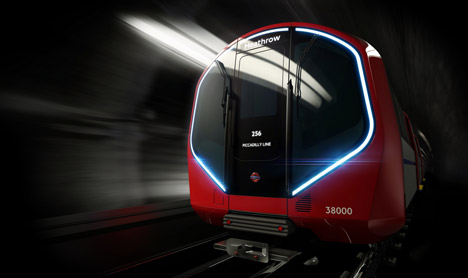
Called the New Tube for London, the designs ditch the traditional carriage layout of existing tubes for one long, complete structure of finite length with air conditioning and Wi-Fi built in. The firm has produced two versions, one with a driver's cab and one that is driverless with seats running up to the front of the cab.
In February, Transport for London published a public advert for a supplier for 250 driverless tube trains for the Piccadilly, Central, Bakerloo and Waterloo & City lines as part of the New Tube for London project, with a contract worth £16 billion.
Asked by Dezeen if the trains had been designed to be driverless, Paul Priestman, co-founder of Preistmangoode, said: "They're adaptable. I can't say too much on the subject but yes… it's future proofed."
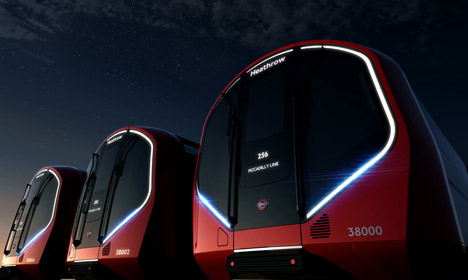
Update: Boris Johnson has confirmed that the first trains will have drivers, but these will be phased and the trains will be automated out by the middle of the 2020s.
"Automation is going to come. This train will allow us to do that," said Johnson at a press briefing this morning.
Images show a frontage that has no immediately visible driver's cab, but a large window surrounded by a strip of curved light created using LEDs with a door in the centre.
"There's a door down the centre which allows people to evacuate through the front of the vehicle if necessary, in an emergency, and it's designed to future proof all developments in cab," said Priestman.
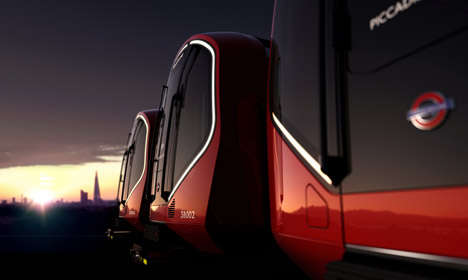
"As a design team we have to allow the thing to evolve through its life. These things are not really going to go into service until 2020, and will run for another 30 or 40 years after that so you have to think about every eventuality that might happen."
The LEDs on the front of the train will glow white when the train moves forward and red when in reverse. LED lighting has also been used throughout the interior of the design and on the doors, which have an in-built traffic light system around the edges to warn passengers when they are preparing to open and close.
Dezeen Book of Interviews: Paul Priestman features in our new book, which is on sale now
The trains will also be air conditioned and be Wi-Fi enabled, and replace traditional paper advertising with "dynamic" screens that can be updated with real-time travel information and advertising messages. They are intended to last for 30 years and run 24 hours a day.
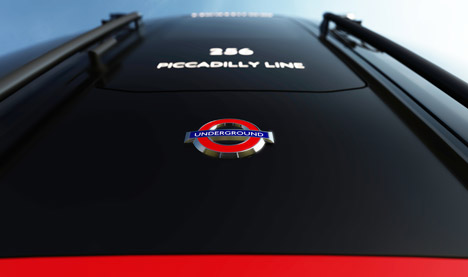
Priestmangoode's designs also include a completely new layout for a London tube train, with double doors spaced evenly along the length of the train and no single doors.
"One of the things that will be happening in the lifetime of this train will be platform doors, which you can already see on the Jubilee Line, and those will be rolled out in the coming years," explained Priestman. "So on this particular train we've been able to make the doors bigger."
"Getting people on and off more quickly allows more trains to operate and then we can get more capacity, so it's absolutely critical to get that right because if you get one train that's moving slowly then the system clogs up. What we're trying to do is work with the limitations we've got to make them as efficient as possible, but also enjoyable and characterful for Londoners."
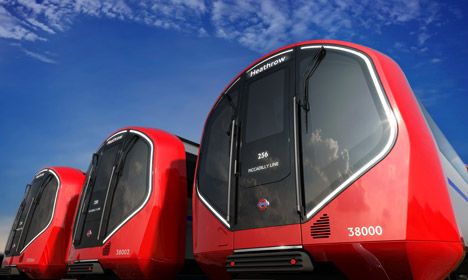
Priestmangoode has worked on a number of high profile transport projects around the world, including conceptual train platforms that move and aircraft interiors designed to create more space for hand luggage.
The company has been working on the New Tube project for three years, working with a series of unusual size limitations thanks to the small height and width of the deep tunnels on the tube, which is the world's oldest underground system.
"It's unique because of the size of the tunnel which everyone knows is tiny," said Priestman. "If you compare the New Tube for London to the District Line trains they're much, much smaller because the tunnels are so old in the way that they were built."
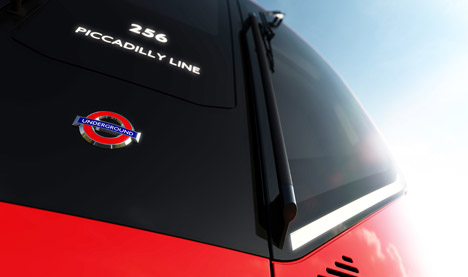
"We built a number of mock-ups and when you take it out of context it looks so tiny. You can barely stand up in the centre of the car, and you forget when you're in the tube train that you are in quite a small space," explained Priestman. "From a design point of view what we're trying to do is just use every possible design skill we have to make it feel as light and as big as possible."
Priestman said that the firm had taken lessons on materials learned from its work designing aircraft interiors and applied them to the New Tube interiors. The colour palette, including charcoal and warm grey, and oxblood red, was "derived from looking at heritage and contemporary architecture and landmarks in London" according to the press statement.
"It's about taking some elements of London and building up a palette of details and colours and finishes and materials which we then use throughout the design," explained Priestman. "So each element will have a London-ness as we would call it, but is still very much part of the brand of the London Underground."
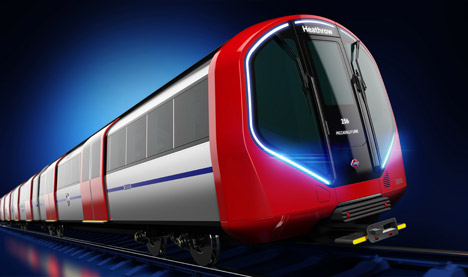
Read on for an edited version of the transcript from our interview with Paul Priestman:
Anna Winston: I hear you have some exciting news?
Paul Priestman: It's great we can talk about it at last. It's a massive project, probably one of the largest orders for metros, and it's unique because of the size of the tunnel which everyone knows is tiny. If you compare the New Tube for London to the District Line trains they're much, much smaller because the tunnels are so old in the way that they were built.
Anna Winston: So this design is pretty unique compared to other things that you've worked on?
Paul Priestman: It's certainly a different requirement because of the size of the car, the diameter of the tube itself is quite small. But then that is just another part of the brief that we have to work around. Obviously you can't make all the tunnels bigger or the stations bigger, it is a replacement vehicle.
Anna Winston: So how big are the trains?
Paul Priestman: I'm not sure exactly of the diameter of the tube but it's amazing because we built a number of mock-ups and when you take it out of context it looks so tiny. You can barely stand up in the centre of the car, and you forget when you're in the tube train that you are in quite a small space. From a design point of view what we're trying to do is just use every possible design skill we have to make it feel as light and as big as possible.
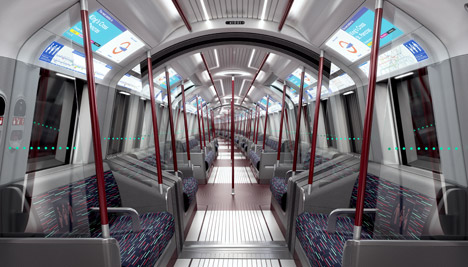
Anna Winston: So tell me a little bit more about what the project involved.
Paul Priestman: We designed all of the interior and all of the exterior. The London Underground train is an icon in itself, it's a symbol of London. So we think very much about - I call it London-ness - I love a sense of a place. I'm also not great at retro either, so it's about taking some elements of London and building up a palette of details and colours and finishes and materials which we then use throughout the design. So each element will have a London-ness as we would call it, but is still very much part of the brand of the London Underground.
Anna Winston: What makes this particular design different from what's come before from other designers?
Paul Priestman: The client wanted something that was unique to London. My personal aim was to just get every square millimetre we can back to the passenger because over-crowding, and the amount of people using the network, is immense. We can't make the trains longer and we can't make them bigger, so the only thing we can do is make what we've got more efficiently.
Anna Winston: So are they one long unit?
Paul Pristeman: Yes they are.
Anna Winston: And that's a finite length?
Paul Priestman: It is yes because of the existing stations of course.
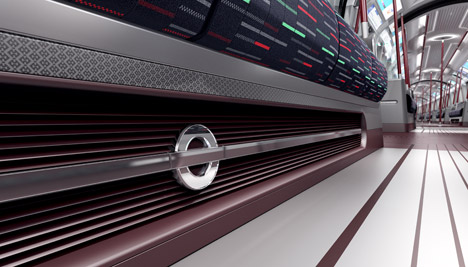
Anna Winston: How long are they?
Paul Priestman: They range from about 12 cars to 13 cars. One of the interesting things about the London Underground trains is that sticking air conditioning units in each car causes a problem, because the doors are actually open more than they're shut because the distance between each station is so close. So if you add air conditioning units all that that would do is push heat out onto the platform. Then when the doors open they'll suck that back in and all that does is add energy and heat to the whole system, the whole infrastructure. So one of the things we're trying to do is reduce the energy we put into the system as a whole, as in the whole infrastructure system. To reduce that, take the energy away and eventually that will reduce the temperature. There's ways of doing that.
Anna Winston: Has anyone done one long single unit train on the tube before?
Paul Priestman: Not on these particular tubes. They're the first, and we're trying to give the character and the feel to it and a familiarity to it so it doesn't feel just like a European train dumped onto the system – a real character of London, of modern London.
Anna Winston: Can you talk me through some of the individual design elements on the front of the train.
Paul Priestman: What we've got is something which is a recognisable face, a modern face, and you'll see that it's got a new lighting system which we've developed for the front, which is a distinctive shape and brings modernity to it. The face of the train is very important – it's the thing you see as it enters the station. The interesting thing about projects like this is that they will be running for forty to fifty years so you're designing something to last an immensely long time and they'll be used 24 hours a day because the tubes will now be operating 24 hours a day.
From a design point of view it's an incredibly rigorous area to work in. It's got to look beautiful but at the same time it's got to be practical because if something breaks and the train goes out of service we have some delay. Normally in product design you're designing something that will last a couple of years and someone will then buy another for a couple of years time, but this is completely different, which is what I love about designing for public transport.
Anna Winston: Are those lights LED strips?
Paul Priestman: They are yes. They're continual light which illuminates round the side, and then when it's in reverse then these glow red rather than white, so it gives the correct illumination but also gives this character and a feeling for London, really.
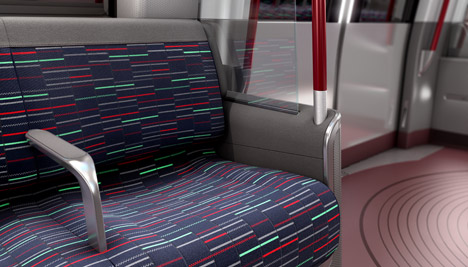
Anna Winston: At the front are those driver's carriages or do they just lead into the carriage like the DLR?
Paul Priestman: There's a door down the centre which allows people to evacuate through the front of the vehicle if necessary, in an emergency, and it's designed to future proof all developments in cab…
Anna Winston: Boris Johnson has been talking about automating the tube eventually, so theoretically these are driverless cabs?
Paul Priestman: It's future proof for that, yes. As a design team we have to allow the thing to evolve through its life. These things are not really going to go into service until 2020, and will run for another thirty or forty years after that so you have to think about every eventuality that might happen. In the interiors we were thinking about screens - dynamic screens rather than advertisements, which allow you to then put information to a lot of people. Should you be on the tube when you go into a packed station and you don't know which station you're at, the displays will change to give you information so that you can find out where you are.
Anna Winston: Are they actually designed for drivers at all?
Paul Priestman: They're adaptable. I can't say too much on the subject but yes… it's future proofed.
Anna Winston: You talked about screens, and they're in the spaces where you would normally have the normal paper adverts?
Paul Priestman: That's right yes, they change the advertisement but then all of the screens can change to tell you which station you're in. In different modes and emergencies it can illuminate or give more light and more information. It's more much connected. One of the big discussions we're involved in in train design, because we design trains around the world, is that the windows themselves can be LED displays so that you can add information on every surface. Even in the last five to ten years on public transport everybody is looking at their phones but not really looking around them. So it's a big discussion whether you beam information to those devices, and again this is all to do with future proofing and how these things will work in years to come, because things will change rapidly and people's user patterns will be very different.
Anna Winston: So they'll be Wi-Fi enabled?
Paul Priestman: Yes. People will be using that much more and guiding themselves through the network on their PDAs telling them to get off at this station, go left, go right, and that's something we have to think about for the future.
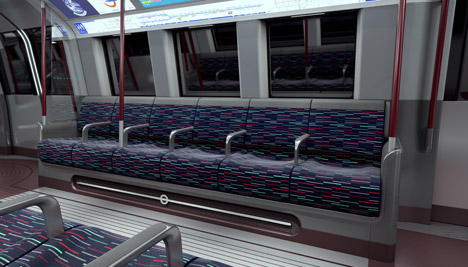
Anna Winston: What else in the design makes it different from an existing tube train?
Paul Priestman: The main thing is the lighting, which is much more characterful. It hasn't got the linear lines that just endlessly run down the train. It's obviously got hardware and surfaces, but the thing that people will notice the most is that it is cool and it feels very much a part of London.
One of the big pushes is to reduce energy consumption and trying to make it very much more efficient. One of the things that will be happening in the lifetime of this train will be platform doors, which you can already see on the Jubilee Line, and those will be rolled out in the coming years. So on this particular train we've been able to make the doors bigger. On the old existing trains you get the big double doors and then you get the single doors, those have actually gone and now they're all double doors but they're exactly regularly spaced along the train.
Anna Winston: Does that improve the passenger flow?
Paul Priestman: Yes. One of the thing we've been working on very closely is how we can get what we've got to be more efficient. Getting people on and off more quickly allows more trains to operate and then we can get more capacity, so it's absolutely critical to get that right because if you get one train that's moving slowly then the system clogs up. What we're trying to do is work with the limitations we've got to make them as efficient as possible, but also enjoyable and characterful for Londoners.
Anna Winston: Can you talk me through some of the materials that you're using for the shell and the interior?
Paul Priestman: Incredibly hardwearing. Non-slip surfaces. Obviously you have to think about wear and the fire issues. But also then trying to get some of the quality feel to it. We design an awful lot of air crafts and we're using materials that we've learned from other industries, so a lot of surfaces are foiled. It's not just a paint finish, so they're very resistant to wear, scratches, even vandalism. It's trying to create something which has got a higher quality feel but is at the same time very durable.
We were talking recently with the New York metro, and it's really fascinating that in New York they have to have seats that are stainless steel or hard materials because of vandalism issues, and they look at London and say 'well how can you have fabric seats? It wouldn't last five minutes in New York'. Why is that? In some cities there are some things that are affected by cultures, and soft fabric seats – it's quite interesting that it's something for London.
Anna Winston: How long have you been working on this?
Paul Priestman: Quite a long time. It's about three years.
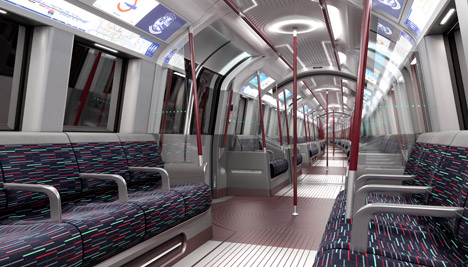
Anna Winston: Are they being manufactured in the UK?
Paul Priestman: I'm not sure - it's going to tender… But something that we've been doing with a number of cities round the world is to create a design vision before it goes to tender. Then the tender is not just to submit a technical cost answer, but also trying to meet the aspiration of the design already agreed. That does save an awful lot of time in the process further on, and it also allows more interesting and more culturally correct vehicles in different cities and countries. In China it's a requirement that you have boiling water in each vestibule, because everyone wants tea on high-speed trains. We've been working on trains in New Zealand where there has to be surfboard storage rather than bike storage, so there's lots of different things that you have to think about. More people are taking bikes on trains now, and how does that work and how does that affect capacity and how does that affect spaces?
Anna Winston: Given that you're working on all these projects what's the one thing that makes this one particularly different from the others?
Paul Priestman: The character of London. We're trying to keep it contemporary and modern and moving it forward. If you made it look like the train cars on the street today then it will be out of date in five years time.
Anna Winston: Do you know what the material specifications are for the floor?
Paul Priestman: It's a single sheet material which is printed and then debossed as well. It has to be non-slip and one of the requirements right now is to have a different colour where the doors are so you can detect where the doors are from a distance. One of the things we tried to do with the shape of the flooring is to try and encourage people to move down the cars and to lead you through but then also to give you some way finding so where the entrances are are lights which then draw you to the entrance.
The edges of the doors will actually change colours depending on their status so that they go green when the doors open and then they start to change colours when the doors are about to close. The idea is it might persuade people from doing a last minute dash because they know that they're not going to get to the door. Also when the lights start changing people start moving from the door and it speeds up that process. We're trying everything we can to get people on and off trains as quickly as possible.
Additional reporting by Jessica Mairs